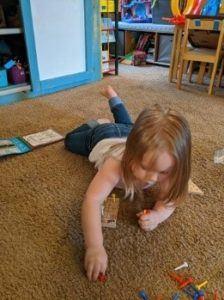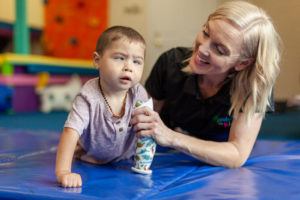Month: October 2019
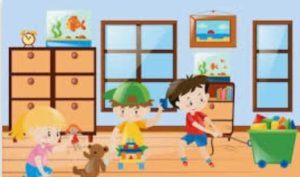
With the cold weather setting in, all us parents are ramping up for the increased energy of our children that can no longer go outside for very long! We all know that kids, and even adults, are not made to sit still indoors all day no matter how hard it is to keep them entertained. Here are a few ideas that can help to keep your kiddos regulated and happy along with you!
- Have a Dance party! Turn up the music, push back the coffee table and turn on that old dance light you have tucked away in your holiday gear. Visual (lights), auditory (sound) and proprioceptive (pressure) needs can all be met in this task!
- It might be cold outside but it can be a summer sensory bin indoors! Bring that water table indoors and fill it up with water beads or colored rice and have an out of season underwater play session!
- The traditional Fort building for bored children can provide a calming quiet area that children can read books or even take a nap, if we’re lucky! The actual task of building a fort can provide opportunities for heavy work such as carrying the blankets (calming proprioceptive input) and the cognitive problem-solving task of where to hang and put the blankets to construct it has wonderful benefits as well!
- Don’t be too quick to count out all the outdoor tasks. Sledding is a great vestibular task that can meet the needs of a child that may like to swing outdoors on sunnier days. It can also provide calming heavy (proprioceptive) input as they walk back up the hill whether they are pulling the sled back or not.
- Get your indoor adventure time on with an Animal Rescue!! Hide stuffed animals, weighted beanie babies are perfect, and have your child go find and rescue them! This can help to get them moving in a more motivated fashion while also applying their visual scanning skills and keep them busy for quite few minutes.
- Move that outdoor equipment indoors!! If you have a basement or area that can fit a small climbing structure, mini trampoline, slide or rollercoaster from outdoors in, hose it off now and keep the outdoor play going all winter!
- Make your own or just play with Playdough! This task can help to strengthen fine motor skill as you use approaching holiday cookie cutters for them to make their own “cookies” to design.
- Have a guess the animal Zoo-fari!! Have your child walk like various animals, kangaroo, frog, monkey, elephant etc, and guess what animal they are! This can provide calming pressure as well!
- Messy play sensory bins such as “oobleck” which is made out of corn starch and water, can be used for enticing their attention for a long time and providing such a different sensory experience that they couldn’t possibly be bored! Feel free to throw in safe plastic toys for a fun search as well!
- Channel your inner Frozen and freeze toys inside a container or ice tray. Fill up old ketchup or mustard containers and fill with warm water to squeeze and melt the toys out
Celeste Roberts, MS OTR/L

As parents we are conscious of our child’s sensory system likes and dislikes and often cater to them without even realizing. We rock them as a baby which is meeting their “vestibular need” or hug them when they are tired which provides input to their “proprioceptive” system that helps them to calm. What we are not often as aware of is that these sensory system needs are part of their “daily sensory diets”. Being a parent requires you to read their needs and adjust accordingly before they even have the words to tell us what they want or need. As they fidget and become fussy a quick 10 minutes of outside heavy work and some fresh air with built in deep breathing seem to work magic on their moods and ability to cope with life and the struggles it hands us all. It is actually not magic, but the magic of sensory regulation strategies.
Sensory Break examples:
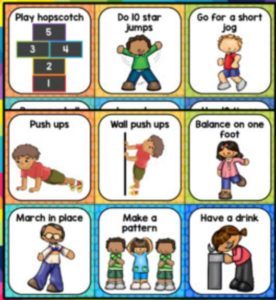
Every child, and every adult, has sensory needs throughout every day of their life and these needs fluctuate and change over time. This is a skilled intervention that occupational therapy can provide and help to find the just right challenge and just right sensory diet in order to increase positive mood, task focus, and independence for your children. On days that your child seems to be jumping around on the furniture more, running and “crashing” into the couch or bed they are most in need of proprioceptive input. On days that your child is having a harder time coping with even the littlest inconveniences or changes in schedule these proprioceptive tasks can also be helpful in calming our bodies such as hugs, jumping jacks, or jumping on a trampoline. If your child seems fearful of height, such as climbing to the top of an outdoor play structure, or is unwilling to swing or use a trampoline they are likely in need of skilled intervention in order to address this vestibular tolerance deficit. As parents we adjust to what our children need, though when realizing there are needs that are becoming harder to fulfil or is impacting your child’s ability to play with other peers, skilled occupational therapy may be the next step in the best thing you can do to help your child succeed!
Celeste Roberts, MS OTR/L

Read More
Sensory Bottles
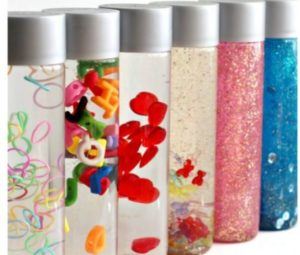
What a fun and easy activity to do in your home with your child! Calming bottles are great for sensory play and to calm an anxious child.
What you will need:
- A clear bottle with lid
- food coloring
- items you want to put in your bottle (beads, glitter, Legos) You decide!
- water
- baby oil
- glue
Directions:
- Fill bottle 1/2 water
- Fill bottle 1/2 baby oil
- Insert desired items you want in your calming bottle
- Drop your food coloring to your desired color
- Glue your lid so child is not able to open
- Enjoy!
Watch our instructional video below:
Read More
Outpatient Therapy Services
*Children of any age are referred to ABC Pediatric Therapy by their physician due to concerns with gross motor, fine motor and/or speech and language skills.

*Children are evaluated by the Therapist who is trained and specializes in the area of concern (Physical Therapist, Occupational Therapist or Speech Language Pathologist) using a functional evaluation. The family is involved in setting goals in the best interest of the child.
*After therapy is recommended, the Therapist shares the strengths and goal areas for the child with the parent and determines with the parent priorities for functional goals.
*Direct, one-on-one therapy is provided by the Therapist in the outpatient center with the parent or caregiver present; a home exercise program is established for optimal carry-over at home. Visits are scheduled based on the needs of the child, typically one time per week and up to five times per week if necessary.
*The family’s insurance company is billed for the therapy sessions; alternative funding is available as needed.
**A therapist is college educated on normal and abnormal child development often having a masters or doctorate degree.
Early Intervention Services
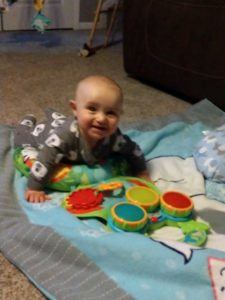
*Children (ages birth through three years old) are referred to Help Me Grow by anyone having a concern with the child’s development in any area – behavior, gross motor, fine motor, speech or cognition. (This could be a parent or physician)
*Children are evaluated by at least two different specialists using a standardized test to determine eligibility for services.
*After eligibility is determined, the family is involved with the team in establishing an IFSP (Individualized Family Service Plan) which identifies the family’s primary concerns. Based on these concerns, outcomes (goals) are established and a PSP (Primary Service Provider) is determined. (These outcomes are supposed to be related to the family’s daily routines – i.e. meal time, bath time, etc.)
*The PSP, often a Developmental Specialist*, rather than a Therapist (PT, OT or SLP) sees the child at home or other natural environment (such as daycare or babysitter). Visits are typically scheduled monthly. If available, a licensed therapist may consult and advise the Developmental Specialist on how to encourage development.
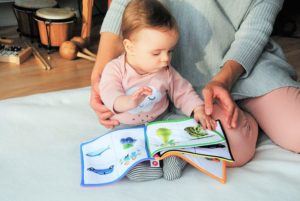
*The coaching model is used – the PSP coaches the family to carry through the activities vs. providing one-on-one therapy.
*The first 55 hours of services in a year are provided at no cost to families. If more than 55 hours are needed, the families may then be charged for additional services through the family’s insurance or other means.
*Developmental Specialist: A professional, certified by the Ohio Department of Developmental Disabilities, trained to develop and implement a program which works to enhance a child’s developmental needs birth-age 3.
If you feel outpatient service would best meet your child’s developmental challenges, reach out to us at http://www.abcpediatrictherapy.com. We are here to educate you and inspire your child.
Read MoreThere are many different tapping methods available in the clinic and many reasons why we would try taping. See below for specific ways tape can be helpful and when we would not use tape. For children, tapping is most helpful with improving function and promoting postural control to help facilitate gross motor, fine motor, or oral motor skills.
Kinesiotaping can help with:
– Improve muscle function
– Improve sensory awareness
– Support ligaments and tendons
– Improve lymph/blood circulation
– increase range of motion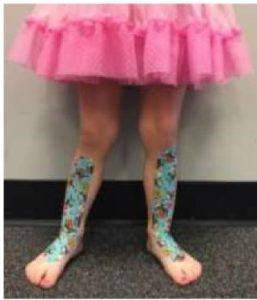
– Decrease edema/swelling
– minimize pain
– limit muscle fatigue
– delay onset of muscle soreness
– decrease scars/adhesions
– assist with organ dysfunction
– prevent injuries
– reposition joints
– improve postural alignment
– improve gross/fine/oral motor skills
– improve balance
– improve walking patterns
– facilitate breathing
It would not be appropriate to use Kinesiology taping with children that have the following:
– open wounds/cuts/scrapes/rashes on the areas that tape would be applied
– non-healed scars
– thin/fragile skin
– infected area
– kidney Problems
– a known allergy to adhesives/acrylic/silicone
– Congestive heart failure
– Deep Vein Thrombosis (DVT) or blood clot
Precautions would need to be taken with the following:
– Previous reactions to tape/adhesive
– Decreased sensation
– GI issues such as severe reflux
– Infant in NICU
– Rash/eczema
– Pica disorder
– Suspected DVT
– Taking anti – coagulant
– Diabetes, venous insufficiency peripheral neuropathy
As a pediatric physical therapist, I like to use taping to facilitate function. For example, I use tape to assist with heel strike with my kids that like to walk on their toes. This has been very successful with my sensory seeking toe walkers, especially because not only does it assist with muscle activation in the front of the foot it also provides sensory feedback to the brain. I also use it to assist with babies that have torticollis to assist with symmetrical posture and strengthening the weak side. It is very common for a baby with torticollis to favor a side throughout development due to one side of the body being weaker than the other. Tapping gives feedback to the baby to use their weaker side more appropriately. Taping can also be very helpful to prevent knee hyperextension with children that are hypermobile and like to lock their joints out. When children lock their joints out, they are not activating their muscles surrounding that joint appropriately and therefore not gaining strength. Taping can assist with placing the body in a more functional position so the child gains strength appropriately.
If you feel taping could help your child please feel free to speak to a physical therapist by contacting us at (513)-755-6600 or by https://www.abcpediatrictherapy.com/contact-us/
Read More Skip to content
Skip to content
